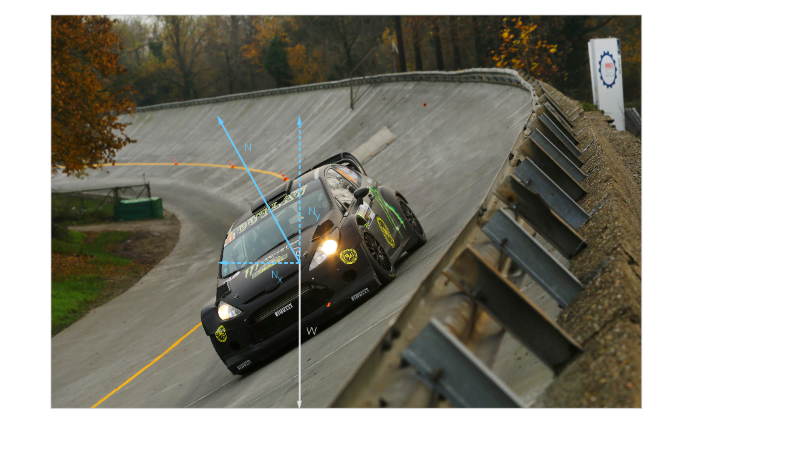Some Examples
Mass and Cornering Speed for Cars
PROBLEM: Let us now ask a simple related question: Given two vehicles - one of mass m and one of mass 2m, which vehicle can round a bend on a level road faster given the same tires (friction coefficient) on both vehicles? Try to work this out before reading the answer.
SOLUTION: Since normal force is on a level surface, the more massive car obviously has twice the normal force. Given twice the normal force and the fact that friction force is the friction force is also doubled. So what effect does this all have on the accelerations of the two cars? Note that I've used subscripts to denote the car of mass and the other of mass In this context, this is centripetal acceleration So if this is true, both cars can go around the same turn at the same speed given equal friction coefficients.
There is only one problem with this result: reality. In reality the lighter car can corner faster on the same rubber. What this tells us is one of two things: Either physics doesn't work or we have made some unrealistic assumption(s). What happens in reality is that cornering adhesion is dependent on friction between the tires and the road, but at the limit of adhesion, tires are under enormous shear forces. Shear forces are what you feel when you rub your hands together, or what a rubber eraser experiences when you erase an undesirable pencil mark. Shear forces arise any time two materials in contact attempt to move parallel to one another in opposite directions.
What you've certainly noticed about erasers is that they leave little pieces of rubber behind on your paper. The shear force on erasers breaks down the rubber. The little pieces of eraser that break off do so because they stick to the paper better than they stick to the rest of the eraser. The material breaks down. While material is being sheared off of any object, the effective friction coefficient is reduced. The same happens to car tires. The evidence is the fact that if you look at any racetrack, those places where cars corner hard, the track is all black from the little pieces of rubber from tires.
So the more massive car has twice the shear force as the less massive one while cornering. To allow it to corner just as fast, we would have to spread that shear force over an area twice as large. Twice the area is required because the material breakdown is really breaking molecular bonds. You will need twice as many bonds to withstand twice as big a force without breaking. So if we put tires twice as wide on the car with double the mass, it will corner just as fast as the smaller car - all else being equal. This dependence of friction force on surface area is often ignored, and sometimes does not matter, but clearly sometimes it does matter. As a simple and generally reliable rule, when one surface looks different for having slid across the other one, surface area has an effect on the friction coefficient. Smooth metal on a plastic table shouldn't have much dependence on surface area. Sand paper on wood should.
Three Problems in One
While on the topic of cars rounding corners, let's consider the case of a car that is rounding a corner on a banked track. In such cases there is another force besides friction that can contribute to the cornering effort - the normal force If the track is banked at an angle then the normal force is tilted from the vertical toward the center of the circular path by the same angle. Let's work out the details of this problem to see how the physics all works out, and then we'll relate the results to two other seemingly different, but really identical problems.

We will first consider the case where friction does not contribute at all. In other words, the banking alone allows the car to round the corner. As mentioned before, a coordinate system must be chosen before starting to do any real work. As a general rule, we should choose the coordinate system in the direction of acceleration. Since we are in the business of adding up forces using Newton's second law, and since those forces lead to acceleration, it is the acceleration we should be focused on when choosing a coordinate system.
In the case of a car rounding a turn on a banked track, the acceleration points parallel to the ground toward the center of the circular path around which the car is driving. Let's call that the x-direction, and direct the y-axis upward. With these choices in mind, remember what we know before doing any work: We know that acceleration is in the +x direction, that it's magnitude is and that therefore the acceleration in the y-direction is 0.
Now we can write: One simple way to solve these equations is by putting mg on the other side of the y equation, and then dividing the x equation by the y equation. This gives Since is gone from this equation, you would need to solve for the other unknown and plug back into either the x or y equation above to retrieve . That part is just algebra, not physics.
Now let's discuss two other identical problems as far as the physics solution is concerned: A plane flying at level altitude while in a banked turn, and a conical pendulum. A plane in level flight has weight acting downward and a lift force acting upward. In level flight these two are balanced. When a plane banks left to turn, what happens is the lift force remains perpendicular to the wing surfaces and is tilted from the vertical toward the inside of the turn by the banking angle. This is the same thing that happened to the normal force on the car on the banked track. Replacing with in the equations above will give the results for the airplane problem.
A conical pendulum is a system such as a string with a mass on the end of it. If we swing the mass out to the side and release it, it becomes an ordinary pendulum. To make it a conical pendulum, you need to swing the mass such that it traces out a circular path around the vertical axis which defines its dead hanging position. In this sense, it has a constant speed and stays level. When just hanging from a string and not yet moving, the tension upward cancels the weight downward. Once tracing out a circular path, the tension tilts inward toward the center of the path by an angle In that orientation, the y component of tension cancels the weight, and the x-component provides a centripetal force - just like the normal force did in the car problem. So you see, as far as the physics is concerned, a car on a banked race track, an airplane in a banked flight trajectory and a ball spinning in circles attached to a string are all the same problem. It's generally a good idea to notice such things because over time you will see patterns of similarity all over the place, and the world will seems more ordered and problems will seem easier to solve.
When Gravity Plays a More Direct Role in Circular Motion
In all of our previous examples, gravity was in the equations, but not as a direct contributor to the turning. What I mean is that gravity was directed downward, and the centripetal acceleration was directed horizontally. Let's now consider problems where the centripetal acceleration is along the vertical axis with gravity. In order to make this happen, all we need to do is travel in circular paths turned on their sides - like the paths of passengers on a Ferris wheel.
Assume that passengers are sitting on perfectly flat seats. Ignore the back rests and seatbelts. If not in motion, passengers experience weight downward and an equal normal force upward. Now assume that the Ferris wheel is turning such that passengers are traveling at a speed v. If we look at a passenger at the bottom position, only two forces are acting, the downward weight and the upward normal force. Which do you suppose is larger, and why? Take a moment to think about this. If you feel like you have no basis from which to reason, consider that you should know at least the direction of the acceleration of the person.

Since the acceleration due to traveling around a circular path is directed inward toward the center of the Ferris wheel, we know that at the bottom position acceleration is upward and at the top position acceleration is downward. If we look at the bottom position first, notice that there are only two forces playing tug of war on the person - gravity pulling them downward and the normal force pushing upward. In order for acceleration to be upward, the normal force must be the bigger force. How much bigger is it? All we need to do is write out Newton's second law. I will consider upward the positive y axis. In that case we get:
Solving for the normal force we find The term in parentheses can be referred to as the effective gravitational constant Why? Because, all the things that gravity normally affects - how quickly objects drop, how easy it is to jump, how much a scale would say you weigh - would all be increased if performed at the bottom position on the Ferris wheel. If that value in parentheses was 2g you would feel twice your normal weight, balls would drop at etc.
Earth's Gravitational Constant
Notice that in the last section where we discussed the Ferris wheel that when the center of a path is toward gravity (downward), that you feel lighter. What then do you suppose the consequence is of earth's rotation on our measurement and perception of gravity? Do you think that the effective gravitational constant would be larger or smaller if the planet didn't rotate?
If you thought that the effective constant would be larger, you are correct? Why is this? Because as the planet rotates, objects on its surface are undergoing centripetal acceleration toward the earth's center. So standing at the equator, you have a normal force upward and a gravitational force downward. The normal force is smaller. How much smaller? The same exact physics of the Ferris wheel applies: What we call is the effective one which already accounts for earth's rotation.
We should be clear about what this implies, and should call attention to something which most times is assumed to be true, but actually isn't. For stationary objects on level surfaces, the gravitational force does not equal the normal force at any location on earth except for the north and south poles! In most cases we are fine with the small error of around 0.5% and ignore this fact, but take note that since scales measure normal force, you are actually measuring something a little smaller than the force of gravity when you stand on a scale. This means the weight you measure is not mg.
This concept of effective gravitation will be extensively discussed in the next chapter.